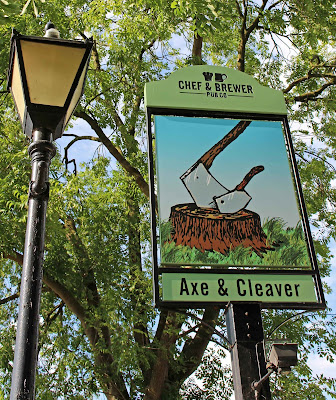‘Keep your libraries, your penal institutions, your insane-asylums ...
give me beer. You think man needs rule, he needs beer. The world does not need
morals, it needs beer ... The souls of men have been fed with indigestibles,
but the soul could make use of beer.’ ~ Henry Miller
Here are some more of the pubs in Cheshire
The
Bricklayers Arms, Altrincham
Now sitting on the outskirts of Manchester
The sign is interesting. It shows a
variation of the coat of arms of the Worshipful Company of Tylers and Bricklayers, one of the ancient Livery Companies
of the City of London London
The
Axe and Cleaver, Dunham Massey
This is one of the few pubs I’ve blogged
about that I’ve actually had a drink at.
Sitting in the garden on a hot
summer’s day, sipping on a rather delicious thirst-quenching pint of cider, was
perfect after a long walk along the Bridgewater
Canal
The Axe and Cleaver dates from around 1880 and was originally a
private house whose owners held a beer licence. It has since been modified and
added to, though the coaching-inn-style outbuildings are original and are listed
buildings.
The setting is delightful and I’m told the food is hearty so it’s a
great way to end a day out at the National Trust property at Dunham Massey, which
is close by.
This public house is around 300 years old
and is one of the meeting places for the Cheshire Hunt, so is aptly named. And,
though I don’t approve of hunting hares with hounds, I have included it here
for its interesting signs. The one showing the frantic hare being pursued by
eager hounds is the usual image associated with this type of hunting but I much
prefer the image on the other sign, where the hare sits calmly in a clump of
grass on one side of a stream while the two hounds stand thwarted from their
blood-thirsty work on the other side. One up for the hare!
The
Tunnel Top, Dutton
According to its own website, the Tunnel Top
has stood above the
Preston Brook Tunnel on the Trent
& Mersey Canal
This public house was formerly named the
Talbot Arms, after its landlord Mr Talbot, who retired not too many years ago
at the grand old age of 93. And, as the website says, it is perfectly situated
for a beer at the end of a countryside stroll.
This is another public house where I’ve enjoyed a drop of the
local cider, as it is alos perfectly situated, on a quiet side road off the A9 and
just along from a charming old country church that is also worth a look.
The
Arms is said to be 400 years old and is a charming maze of tiny rooms and
alleyways.
The coat of arms on the sign comes from the Chetwode family, the
most famous of whom was Sir John Chetwode (1764-1845), who was born in Cheshire ,
in Stockport, and served as Cheshire
I’m
not sure of the family’s connection with this particular pub – perhaps they
owned the land hereabouts at some point.
I grabbed photos of these last two pubs
during a very brief visit to Sandbach to see the town’s famous 9th-century Anglo-Saxon crosses, and I was so charmed by the bear on the roof of the Old Black Bear that I
forgot to take a close up photo of the pub’s sign.
As you can see from the photo, this is a very old building, dating from 1634, and a wonderful example of the
half-timbered properties to be found in many of Cheshire
This public house is much more recent
than the Old Black Bear, built in 1890 at the request of Lord Crewe to provide
a shuttle service for travellers to Sandbach Station, according to Joan Alcock
in her book Cheshire Inn Signs (The
History Press, Stroud, 2008). Apparently, it also served as the headquarters
for the American GIs who were billeted in this area during World War Two.
I haven’t discovered the origin of the
pub’s name but a wheatsheaf would’ve been a common sight in the fields surrounding
the town in the days before modern harvesting equipment, and the sign is a
lovely example of the art of signwriting.








No comments:
Post a Comment